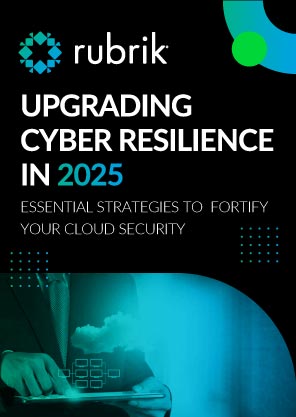or call: +1 (845) 347-8894

or call: +1 (845) 347-8894

Cloud security in 2025 has emerged as the most talked theme in the cyber technology landscape. In today’s digital age, organizations are increasingly relying on cloud security solutions to enhance their operations and drive innovation. Cloud security solutions could help. However, this migration to the cloud also introduces new cybersecurity challenges. In the last two years, almost 99% of IT and security leaders have cited experiencing at least one cyberattack. To ensure the safety and integrity of your cloud environment, it’s crucial to develop a robust cyber resilience strategy.
Modern cloud security policies are sustainable when CISOs have a clear cyber resilience roadmap. Cyber resilience is the ability of an organization to continue operating effectively in the face of cyber threats. It involves a combination of proactive measures, reactive responses, and a focus on business continuity.
In an era where digital connectivity is the norm, the significance of cyber resilience has never been more pronounced. With the rapid evolution of technology and the increasing complexity of cyber threats, organizations must recognize that a successful cyber strategy goes beyond mere prevention. The reality is that cyber attacks are not a question of “if” but “when,” and the repercussions can be dire.
As organizations increasingly rely on cloud services for their operations, ensuring robust cloud security has become a critical component of any comprehensive cybersecurity strategy. However, the complexity of cloud environments introduces unique vulnerabilities that can put sensitive data and business continuity at risk.
Cyber resilience transcends mere protection; it embodies an organization’s ability to prepare for, respond to, and recover from cyber incidents in real-time.
For CISOs and IT leaders, this means adopting a proactive mindset that not only fortifies defenses against attacks but also equips teams with the tools and strategies needed to maintain operational integrity in the face of adversity. In this context, cloud security becomes not just a technical requirement, but a vital pillar of organizational resilience that can safeguard assets, uphold regulatory compliance, and preserve stakeholder trust.
Cyber resilience is the ability of an organization to prepare for, respond to, and recover from cyber attacks while continuing to deliver critical services. This multifaceted approach encompasses not only robust cybersecurity measures but also strategic planning, risk management, and organizational readiness.
Recommended: How Cybersecurity Certifications Fill the Security Loopholes
Cyber attacks can compromise sensitive data, including personal information, financial records, and proprietary business insights. The loss of this data can lead to legal and regulatory repercussions, as organizations are obligated to protect the privacy and integrity of the information they handle.
The financial fallout from a cyber incident can be staggering. Organizations may face direct costs such as legal fees, regulatory fines, and expenses related to incident response. Indirect costs, including loss of business and long-term damage to customer trust, can further exacerbate the financial impact.
A cyber attack can tarnish an organization’s reputation, leading to a loss of customer confidence. In an interconnected world, news of a breach can spread rapidly, making it crucial for organizations to maintain transparency and demonstrate their commitment to cybersecurity.
Cyber incidents can disrupt normal business operations, leading to downtime that affects productivity and service delivery. A resilient organization must be equipped to maintain operations during and after an attack, ensuring that critical functions can continue without significant interruption.
According to research from Rubrik, the likelihood of experiencing a cyber attack is a very real concern for organizations today. With sophisticated attack vectors and increasing prevalence of ransomware and other malicious tactics, businesses must prioritize their cyber resilience strategies.
Organizations must not only invest in technology but also foster a culture of preparedness. This includes ongoing training for employees, regular assessments of security posture, and comprehensive incident response planning.
Cyber resilience is a critical aspect of modern IT security. It’s more than just preventing breaches; it’s about the ability to quickly identify, respond to, and recover from security incidents.
A robust cyber resilience strategy is built on a proactive approach that assumes a breach is inevitable. Rather than focusing solely on prevention, organizations must develop a comprehensive plan to address incidents when they occur.
This plan should include:
By adopting a proactive and risk-focused approach, organizations can significantly enhance their cyber resilience and protect their valuable assets. To achieve true cyber resilience with a modern cloud security approach, organizations should consider the following strategies:
A comprehensive risk assessment is a fundamental step in building a robust cyber resilience strategy. By identifying potential threats and vulnerabilities, organizations can prioritize their security efforts and allocate resources effectively. A thorough risk assessment should evaluate various factors, including the likelihood of different types of attacks, the potential impact of such attacks, and the effectiveness of existing security measures. This information can then be used to develop a tailored plan to mitigate risks and enhance overall cyber resilience.
Steps to follow:
#1 Regularly evaluate your organization’s vulnerabilities and threat landscape.
#2 Understand the potential impact of different types of attacks and prioritize resources accordingly.
Protecting sensitive data is a critical component of cyber resilience. Organizations must implement robust data protection measures to prevent unauthorized access, loss, or alteration of information. This includes encrypting data both at rest and in transit, implementing access controls, and regularly backing up data to ensure recovery in the event of a breach. Additionally, organizations should have clear data retention and disposal policies to minimize the risk of sensitive information falling into the wrong hands.
Steps to follow:
#1 Implement robust data backup and recovery solutions to safeguard against data loss.
#2 Ensure that backups are secure, regularly tested, and easily accessible.
A well-defined incident response plan is essential for effectively managing and mitigating cyber security incidents. This plan should outline the steps to be taken in the event of a breach, including incident identification, containment, eradication, recovery, and lessons learned. Regular testing and drills are crucial to ensure that teams are prepared to respond effectively to incidents and minimize their impact on the organization.
Steps to follow:
Develop a comprehensive incident response plan that outlines roles, responsibilities, and procedures in the event of a cyber incident.
Regularly test and update the plan to ensure its effectiveness.
Continuous monitoring is a critical component of a robust cyber resilience strategy. By continuously monitoring your cloud environment for threats and anomalies, you can detect and respond to security incidents in a timely manner. This involves using a combination of tools and techniques, such as network traffic analysis, intrusion detection systems, and security information and event management (SIEM) solutions. Regular monitoring and analysis can help identify vulnerabilities, assess the effectiveness of security controls, and detect potential threats before they can cause significant damage.
Employ advanced monitoring tools to detect anomalies and potential threats in real-time. This proactive approach can help mitigate risks before they escalate.
As a leading cybersecurity cloud solutions provider, Rubrik offers unmatched protection for your organization’s critical data. Its unique immutable backup architecture ensures that your backups are safe from ransomware attacks, providing a crucial line of defense against cyber threats. With Rubrik’s comprehensive visibility into your data and systems, SecOps teams can proactively identify and address vulnerabilities, minimizing the impact of cyberattacks. Its rapid recovery capabilities allow faster route to restore individual files, applications, or entire systems quickly, ensuring minimal downtime.
Cloud security platforms enhance operational effectiveness and drive innovation. This solutions are designed to protect cloud-based resources and data from unauthorized access, breaches, and other cyber threats. These platforms offer a comprehensive suite of security features and capabilities. Migrating to modern cloud security is the top priority for most CISOs in 2024. And, this could continue in 2025.
However, this migration to the cloud also introduces new cybersecurity challenges.
To ensure the safety and integrity of your cloud environment, it’s crucial to develop a robust cyber resilience strategy. Here are the key components of a modern CISOs cloud security-based cyber resilience strategy.
In today’s interconnected digital landscape, organizations rely heavily on third-party vendors and suppliers to deliver essential services and products. However, these relationships also introduce new security risks. To mitigate these risks and ensure the integrity of your cloud environment, it’s crucial to implement effective third-party risk management and compliance measures.
By effectively managing third-party risks and ensuring compliance, organizations can strengthen their overall cloud security posture and protect their sensitive data.
A strong cyber resilience strategy offers a multitude of benefits that are essential for organizations navigating today’s complex digital landscape. First and foremost, it enhances an organization’s ability to withstand and recover from cyber attacks, minimizing downtime and operational disruption.
Top CyberTech News: Rubrik and Pure Storage Unite for Enhanced Cyber Resilience
By prioritizing proactive measures, such as continuous monitoring, regular risk assessments, and robust incident response planning, businesses can quickly identify vulnerabilities and respond effectively to threats. This not only protects critical data and systems but also ensures business continuity, which is vital for maintaining customer trust and confidence. Furthermore, a resilient approach fosters a culture of security awareness among employees, equipping them with the knowledge and tools to recognize and mitigate risks. This holistic engagement across all levels of the organization helps to create a security-first mindset, making it less likely for human error to lead to a breach.
Additionally, implementing a comprehensive cyber resilience strategy can significantly reduce financial losses associated with data breaches and cyber incidents.
Organizations can avoid hefty fines and legal repercussions that arise from regulatory non-compliance, as a well-structured strategy often incorporates measures to meet industry standards and legal requirements. Moreover, demonstrating a commitment to cyber resilience enhances an organization’s reputation, making it a more attractive partner for clients and stakeholders. In a marketplace where consumers are increasingly concerned about data privacy and security, showcasing robust cyber resilience can differentiate a business from its competitors.
Finally, a strong cyber resilience strategy enables organizations to leverage emerging technologies with greater confidence, fostering sustainable innovation and growth.
By ensuring that security measures are embedded in the deployment of new solutions, organizations can pursue digital transformation initiatives without compromising safety. In summary, a robust cyber resilience strategy not only fortifies an organization’s defenses against cyber threats but also creates a sustainable foundation for growth, reputation management, and overall operational efficiency in an increasingly interconnected world.
To summarize in pointers, here are the most easily identifiable benefits of adopting a strong and transparent cyber resilience strategy in 2025:
Other benefits include:
Cost Reduction: By preventing or mitigating the impact of cyber incidents, a cyber resilience strategy can lead to significant cost savings. This includes avoiding costs associated with data breaches, recovery efforts, and potential legal fees. CISOs can demonstrate to stakeholders, customers, and partners that the organization takes cybersecurity seriously, which builds trust and confidence. Eventually, this leads to reduction of cloud operation costs.
Employee Empowerment and Awareness: Implementing a resilience strategy fosters a culture of security awareness among employees. Educated staff are better equipped to recognize and respond to potential threats, further strengthening the organization’s security posture.
Flexibility and Adaptability: A focus on resilience enables organizations to adapt to emerging threats and changing business environments. CISOs can leverage lessons learned from past incidents to refine and enhance security measures continuously.
Support for Digital Transformation: As organizations embrace digital transformation, a cyber resilience strategy provides the framework to deploy new technologies safely. CISOs can support innovation while ensuring that security is integrated into every initiative.
Holistic Security Approach: Cyber resilience encourages a comprehensive view of security that encompasses people, processes, and technology. This alignment enables CISOs to create more effective security policies and practices that protect the organization from a wide range of threats.
Conclusion
In the era of cloud computing, cyber resilience is no longer an option but a necessity. By implementing a comprehensive and effective cyber resilience strategy, organizations can protect their data, maintain business continuity, and build trust with stakeholders. In summary, a cyber resilience strategy empowers CISOs to manage risks proactively, respond effectively to incidents, and support overall business objectives, all while fostering a culture of security awareness and trust.
Latest IntentTech Insights and News:
Mastercard Unveils High-Tech Hub in Pune, India
IBM Acquires Prescinto to Enhance Renewable Energy Management
AI Giant ABBYY Makes a Power Move: Global Headquarters Shift and Leadership Shakeup




